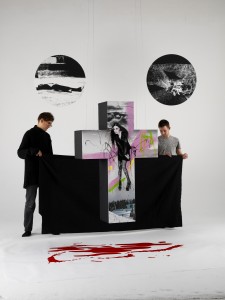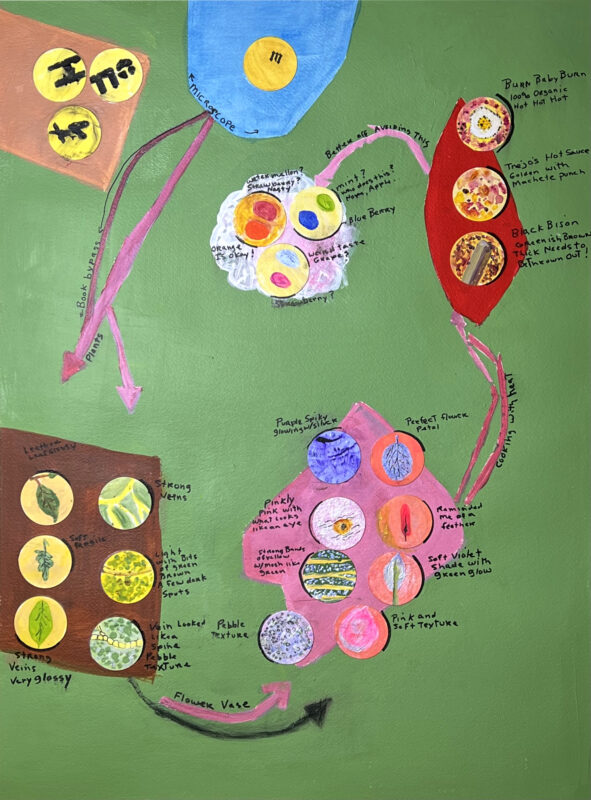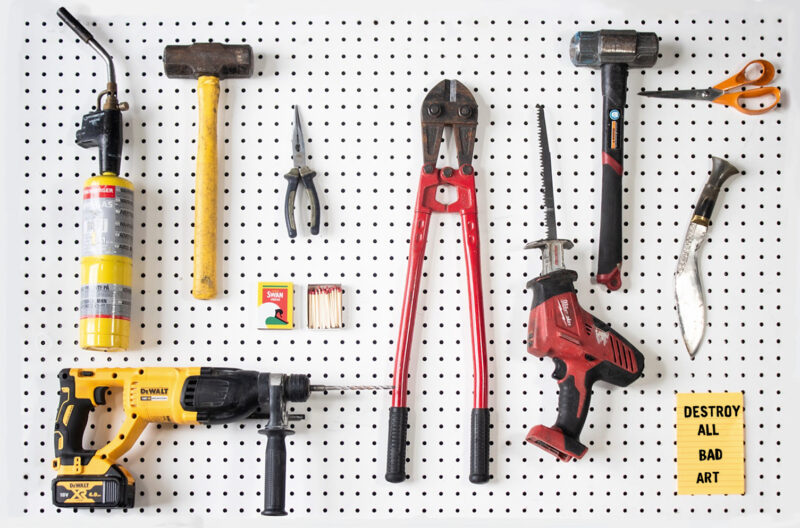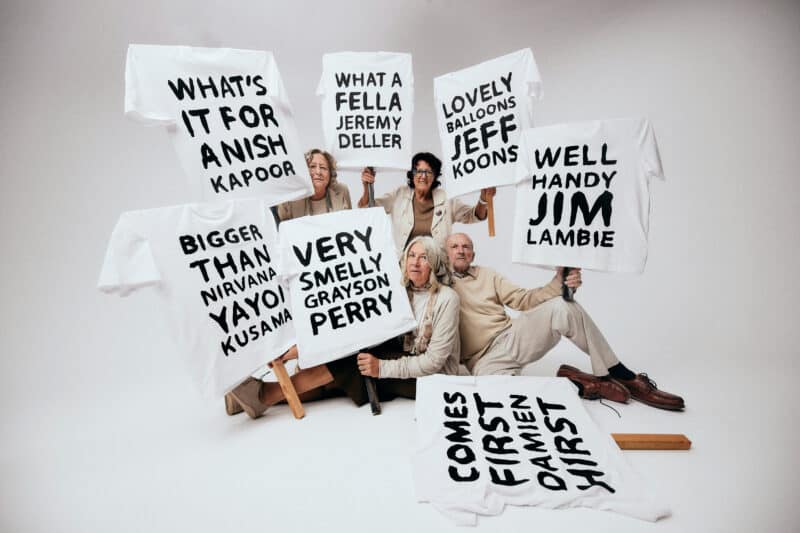
© Richard Valencia, 2009 Stuart Semple
1 When did you start to make art?
I have always made things since I was a very small child, I’d get very fidgety and board if I wasn’t constantly drawing or making.
2 How did you evolve into a professional artist?
Well, I had a very bad turn with my health and after I came back from that I seemed to have a clearer vision of what I wanted to do with my life, that was when I was 19, after that I decided that I wanted to be able to pay for my life with my work so I rented a little terrace house and started selling my drawings, not for very much but somehow I always managed to have the rent and money for food so I suppose it happened when I was 19.
3 What drove you to make art as a professional vocation?
When I was very ill in hospital, I wasn’t sure if I would come out of the hospital again and when I was there I started to question what I wanted to do. Art was the one place that I could always feel free to be me, and although I had a great family and some good friends I always liked to be alone making work, so it was a very natural way to decide to live my life. I just always did it.
4 Explain your inspiration?
That’s a difficult one. Sometimes I feel completely un-inspired; you can’t force a feeling to make work. I think making work starts with a desire to do something and I’m not sure where that desire really stems from. If I knew, things could be a lot easier for me. Then on occasion there will be a really strong longing to realize something and that gives me energy to do it. The way that starts isn’t logical I don’t think it could stem from anything, always an emotional feeling but often some music will cause it or a lyric from a song. It can be a still from a music video or even a conversation, a painting from the past. It just varies all the time.
5 In what way does your inspiration transform into ideas?
I walk around with loads of different coloured books and I capture phrases from songs in them and little doodles. I have my camera and I photograph things, I look through all the fashion magazines and I watch a lot of music videos. I collect all that information and I save it on a massive hard disk then as the feeling comes those things start to group together, sometimes very quickly, other times over years, and in the end they form compositions that become the basis for actual paintings. They kind of grow. Then the paintings themselves are put away and bought out again and added to, or they have bits taken out.
6 From Ideas to production of art – how? And why?
I am not 100% sure why, I think it’s my way of making sense of culture and of the image world we find ourselves in. I want to feel empowered within that, like it can be utilized to make something. I believe in a state and time of hybridity not just of the image but also the whole of reality. I’m intrigued by that riddle – it can be controlling yet empowering, fractured and still make sense. I think I keep doing it because I genuinely feel that I’ve not even scratched the surface of it and that there’s so much more to explore, I don’t feel satisfied with where I’ve been so far.
7 Could your ideas be portrayed in any other medium? If so which?
I think they could, I could see them making sense in a lot of other places because they originate from other sources in the first place. It’s an interesting idea because they could then go full circle to where they could rest in a place in mass culture where they came from. I could see myself directing music videos, or even fashion ads, I could see the ideas working in song (although I’m hopeless at song writing) and even I think dance.
8 Which artists would you most like to blatantly rip off?
The artists I admire most I respect too much to rip off. Of course I wish I could paint like Twombly or have the focus of early Hockney or something. I’d love to be able to translate the feeling I get from a good Dylan song, or have a collection of paintings as good as OK Computer, but I wouldn’t want to rip anyone off. I always deal with things that exist but I always try to be critical of them and to present a point of view.
9 Why is your art made?
It’s made because I really do have a strong urge to dissect the world around me, I want to understand the myth of reality as served up by mass culture. I want to find a language in which I can convey the separation between that constructed world and what it feels to actually be alive. I want to show how desperate that is. I feel very lost in my work most of the time and I keep going to find something that makes some sense, once something seems to solidify like that it gets even harder. It’s made because I’m competitive with the work, I won’t let it beat me and it’s a fight I have.
10 What does being an artists mean to you?
Apart from sleepless nights know an image in the studio isn’t working, it means fighting to have enough distance to make things that are truthful. Of course it becomes part of my identity, but I feel that in itself is fluid, I don’t always feel like an artist, even when I’m painting. That word doesn’t always seem honest to me, unless I believe there’s some success in the piece of work. I rarely feel like that. I’m not sure how much different an artist is from any other person. I’m not sure how other people feel.
11 Are you happy with your reasons for making art? i.e Are there any trade offs that make life hard?
It’s very hard. It’s not the easy way to go about things, the more I make the harder it seems to be to make stuff, everything takes a lot longer. I paint almost all the time, and I see my family very rarely, I gave up any idea of a social life years ago. The big price is a feeling of frustration when an idea isn’t coming together as well as I hoped. It’s hard when it’s how you make a living because there are deadlines for projects and it’s difficult to be inspired on demand. It’s a difficult balancing act where the art making itself can be the price you pay to make art. There’s quite a vicious circle in that process. It’s the ultimate price.
12 When does your art become successful?
It changes depending on my mood or the day. I can look at a work and hate it, pull it out six months later, add a little splat of paint and think it’s a successful piece and then a few hours later want to destroy it. It just fluctuates all the time. If it’s close to what s in my mind it’s successful in one way but sometimes it’s not so, because it’s too rigid to the initial idea. I feel relieved when I manage to let them go, when one is actually finished.
13 What is art?
I think it’s someone’s way of expressing with honestly how they feel and perceive their world. It’s the place where that perception merges with other people’s in a communicative or emotive way. Good art is successful and truthful usage of language.
14 How do you start the process of making work?
In being open and receptive to what is around me and letting it settle in places where I collect things.
15 Who prices your work? And how is the price decided upon?
A work of art is worth what someone will pay for it. So the buyers decide the price, and once a few people have paid a certain amount for something then that sort of becomes it’s value. Although with the world as it is everyone has to be a lot more flexabile about that. I try to stay well away from the numbers of art, I truly believe that art and money are very different forces, that strangely settle together, of course I need both of them to survive but I would rather leave that process in the hands of galleries and dealers, because I’m frightened by things like that. On one hand art as an expression should be free, and on the other I need to pay my rent and buy my materials, so it’s a difficult situation. I wish the more someone loved and understood something the cheaper it became for them to have it.
16 What is your next; move,project,show etc?
Well the New York project is the thing now and after that I will be moving to the country, and travelling a lot to Italy because there is a strange mountain in the hills with a little dolls house. My plan is to stay in the dolls house for some time. Throughout the hill are religious shrines based around the Stations of the Cross, there was a miracle with one of them several hundreds of years ago. I am hoping over the next couple of years to create a series of 14 paintings, one for each Station of the Cross. It’s something I’ve wanted to do for a very long time, and I feel like I need to give each work the time it needs to do it proper justice. I also have a little collaboration planned with the Prodigy. There will be an exhibition in Hong Kong towards the end of the year of existing works from my own collection.
17 What are the pros and cons of the art market?
Well, it enables artists to make art, which is a hugely positive thing. There are so many amazing inspiring and supportive people in the art market. I think it’s easy to mistake that and think that it’s a purely commercial proposition, it really isn’t. There are many people utilising that process to create astonishing and inspiring things. The negative aspect, well there’s greed of course but that’s to be found in any market. The difficulty is when it becomes out of balance and starts to influence the creative process, but generally I think it’s a healthy thing where people who make stuff are matched with people who passionately want to own it.
18 Which pieces would you like to be remembered for?
I don’t know. I mean I have always wanted to make the Angelus painting that’s in the new series, I’m starting to get a bit board with that one now though. There’s a piece called ‘Burnout and Ferment’ that I made about 5 years ago, I think I managed to capture a feeling I had at the time in that piece, and I’ve not managed to do that again. I’m not sure I’ve really made anything yet that I’d really feel comfortable being remembered for, or something I feel completely sums it up. I’m too busy thinking the next series might be more like that.
19 Any routine in making your artwork? If so what?
Well I get up at 6am and I paint till about 10.30, that way the world is asleep and things are peaceful, and during the day I think and read and write and collect and do my food shopping and emails and go to the gym and talk on the phone, then after 6.30 until about midnight I go again and normally end the day with a retro TV show on DVD in bed. I try my best to live every day like that. I’m very comfortable in routine and I feel lost without that stability. And the way I lay out the materials and organize things. I’m a typical Virgo I think!
20 What has been the biggest break in your career?
When Anthony d’Offay convinced me to move to London. I think he was totally right. I was terrified. Then I found this burned out abandoned warehouse and it had no electricity or even windows, my friends and family and I spent weeks sweeping out all the soot, in the end we showed 15 works that I made in a freezing mouse infested studio. But people came to see the pictures, and some sold and some dealers came and it all seemed to start there. It was the start, a slow start not a big bang where things started to go right at all.
21 Who has been the biggest influence on you?
It’s difficult, and there are so many. One tutor from art school, my granddad, quite a few artists, some philosophers. My granddad compulsively made stuff too. My grandmother was a painter. A lot of music. No one particular person.
22 How many artworks have you given away and to whom?
I can’t remember, I give a lot away. Family, friends people who help with projects and things. Charities too sometimes. I did one project in 2000 when I gave away 500 pieces of art from my website to whoever wrote in.
Everlasting Nothing Less by Stuart Semple runs at the Anna Kustera gallery, New York, www.stuartsemple.com







